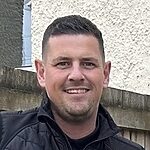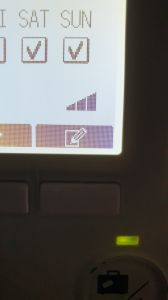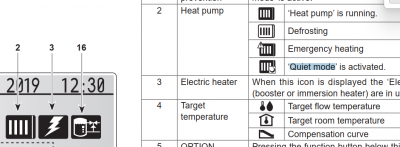@sliderule no worries at all. One black segment is quietest/min power. Three black segments is normal/full power (see photo)👍
Mitsubishi Ecodan 11.2kW R32 ASHP; Ecodan DHW cylinder; UFH+rads
20x430W Jinko TOPCON Tiger Neo solar; Luxpower 6+4kW hybrid inverter; 20kWh LFP battery storage
that's on mine which is a 2021/22 FTC6 btwPosted by: @skd@sliderule no worries at all. One black triangle is quietest/min power. Three black triangles is normal/full power 👍
Mitsubishi Ecodan 11.2kW R32 ASHP; Ecodan DHW cylinder; UFH+rads
20x430W Jinko TOPCON Tiger Neo solar; Luxpower 6+4kW hybrid inverter; 20kWh LFP battery storage
Posted by: @sunandair...it’s flow rate recommendation is around 11 LPM...I have found it’s important to keep Farley close to the recommended flow rate for your model of HP.
To pick up on this (flow rate) comment... I've a Grundfos primary pump which the FTC6 reports as producing 8lpm on constant speed 1, and 12 or 13 (it flip-flops every few seconds) on constant speed 2 - a) I assume the FTC pump speed setting has no effect whether it's 1 or 5, and b) with UFH and rads, what's the guidance on whether I should be at 8 or 12/13; is it just 'nearest the book flow' (e.g. nearest to 10.8lpm) or, with the UFH likely using/being on more, the nearest slower setting?
Unlikely, but c) is there any known way I adjust the Grundfos to get near half way in-between, e.g. ~10.5lpm?!
Posted by: @skdOne black segment is quietest/min power. Three black segments is normal/full power (see photo)
Can I just check this is correct - having read the FTC6 installation manual, the three bar settings are described as Normal / Level1 / Level2; does anyone know what Level1 and Level2 mean, precisely? (I can't find anything on google) Do we not think that 'Normal' is 'Normal quiet mode' (i.e. reduced noise) and not 'normal noise mode', given it's under the Quiet mode settings/schedule?
Posted by: @rhh2348Posted by: @skdOne black segment is quietest/min power. Three black segments is normal/full power (see photo)
Can I just check this is correct - having read the FTC6 installation manual, the three bar settings are described as Normal / Level1 / Level2; does anyone know what Level1 and Level2 mean, precisely? (I can't find anything on google) Do we not think that 'Normal' is 'Normal quiet mode' (i.e. reduced noise) and not 'normal noise mode', given it's under the Quiet mode settings/schedule?
This is what I worked out after speaking to Mitsubishi Tech Support, and experimenting myself. You're right, it's poorly described in their literature.
3 black bars is Normal mode, and refers to standard power / loudest compressor setting.
2 black bars is slightly reduced power, and a bit quieter than Normal. This is Level 1 Quiet Mode.
1 black bar is the greatest available reduction in compressor power. Level 2 Quiet Mode.
Hope this is some help.
Mitsubishi Ecodan 11.2kW R32 ASHP; Ecodan DHW cylinder; UFH+rads
20x430W Jinko TOPCON Tiger Neo solar; Luxpower 6+4kW hybrid inverter; 20kWh LFP battery storage
Posted by: @skdYou're right, it's poorly described in their literature.
3 black bars is Normal mode, and refers to standard power / loudest compressor setting.
2 black bars is slightly reduced power, and a bit quieter than Normal. This is Level 1 Quiet Mode.
1 black bar is the greatest available reduction in compressor power. Level 2 Quiet Mode.
Hope this is some help.
That's an understatement - the manual states the three levels as text (e.g. 'Normal / Level1 / Level2') rather than the number of 'bars'/squares the FTC6 actually displays, and then reverses the order (e.g. rather than 1 bar = Normal, 2 bars = Level1, 3 bars = Level3)! Extremely odd, thus:
However, further down it also states that if quiet mode is enabled, the heat pump icon changes to one with a crescent moon bottom-right, thus:
It'd be nice to know exactly what the two alternative levels adjust, if anyone's got/can find that info?
Will test with quiet mode settings once the W/C is roughly there. Thanks again for now, though.
@rhh2348 yes, the compressor symbol on the main screen will include a moon icon whenever either of the Quiet Mode settings is selected.
I know what you mean - I wish Mitsubishi would provide a written description on the workings of this mode.
Mitsubishi Tech Support verbally told me that each Quiet Mode setting simply places an electronic restruction on maximum compressor speed, nothing more than that.
Mitsubishi Ecodan 11.2kW R32 ASHP; Ecodan DHW cylinder; UFH+rads
20x430W Jinko TOPCON Tiger Neo solar; Luxpower 6+4kW hybrid inverter; 20kWh LFP battery storage
Posted by: @rhh2348Posted by: @sunandair...it’s flow rate recommendation is around 11 LPM...I have found it’s important to keep Farley close to the recommended flow rate for your model of HP.
To pick up on this (flow rate) comment... I've a Grundfos primary pump which the FTC6 reports as producing 8lpm on constant speed 1, and 12 or 13 (it flip-flops every few seconds) on constant speed 2 - a) I assume the FTC pump speed setting has no effect whether it's 1 or 5, and b) with UFH and rads, what's the guidance on whether I should be at 8 or 12/13; is it just 'nearest the book flow' (e.g. nearest to 10.8lpm) or, with the UFH likely using/being on more, the nearest slower setting?
Unlikely, but c) is there any known way I adjust the Grundfos to get near half way in-between, e.g. ~10.5lpm?!
Where is your circulator pump located in the circuit? Is it positioned on the Primary Flow or the Primary Return? Do you have a Mitsubishi pre plumbed cylinder with a plate heat exchanger? And do you know where your flow sensor I see located- as it should be on the return pipework going back to the heat pump? Do you have a Low Loss Header fitted? Regarding c) there is a device called a flow setter valve which simply restricts flow but might not be necessary. One litre faster than optimum shouldn’t be a problem.
dont understand a) what are you assuming. What isn’t happening?
A bit of a late response to this reply, however thank you for doing so, @sunandair.
I've done some more reading around this since my previous post, and thought it'd be useful to cover off some of the points:
- it's not a Mitsubishi (pre-plumbed) cylinder / the flow sensor is on the return pipework, yes / there is a LLH.
- question (a) was to understand if this [the FTC pump speed setting] affected anything other than purely what speed a Mitsubishi pump [for their pre-plumbed cylinder] runs at - e.g. if set to 1 or 5 does that affect something else, like compressor speed, or is otherwise included in any of their algorithms?
- Previously, I'd mangled primary flow rate with UFH zone flow rate, the latter of which is handled by an additional pump on my system - plus, I believe my assumption (that UFH pumps should run slower to provide an optimal reduced flow rate) is incorrect, and that typically one aims for UFH pumps to provide three times the flow of a rad zone! 😳
Posted by: @rhh2348A bit of a late response to this reply, however thank you for doing so, @sunandair.
I've done some more reading around this since my previous post, and thought it'd be useful to cover off some of the points:
- it's not a Mitsubishi (pre-plumbed) cylinder / the flow sensor is on the return pipework, yes / there is a LLH.
- question (a) was to understand if this [the FTC pump speed setting] affected anything other than purely what speed a Mitsubishi pump [for their pre-plumbed cylinder] runs at - e.g. if set to 1 or 5 does that affect something else, like compressor speed, or is otherwise included in any of their algorithms?
- Previously, I'd mangled primary flow rate with UFH zone flow rate, the latter of which is handled by an additional pump on my system - plus, I believe my assumption (that UFH pumps should run slower to provide an optimal reduced flow rate) is incorrect, and that typically one aims for UFH pumps to provide three times the flow of a rad zone! 😳
I believe that the FTC controller can only vary the water pump speed if the actual water pump is capable of having its speed varied. An easy way to check is change the speed setting from 1 to 5 and listen for a change in pump speed.
The actual water pump speed, and subsequent variation in flow rate, is one of the factors which determines how much thermal energy is being transported from the heat pump to the heat emitters.
If the flow rate is say 10 lpm and the DT is 5C, then a certain quantity of thermal energy will be transported. If the flow rate is now increased to 20 lpm then to transport the same quantity of thermal energy the DT must reduce to 2.5C.
As the heating demand increases, the options from a control point of view is to run the water pump at constant speed and allow the DT at the heat pump to vary, or vary the water pump speed to maintain a reasonably constant DT.
If you can vary the water pump speed between 1 and 5 by means of the FTC, then it may be possible to identify the setting that produces a DT of approximately 5C when the heating demand is at a maximum.
With regard to the required flow rate through UFH as against radiators, I suspect it will depend upon the heating capacity of the UFH and radiators. If you pass 3kW of thermal energy into both radiators and UFH, and both are capable of emitting 3kW of thermal energy, then the required flow rate and subsequent DT should be approximately the same.
-
Ecodan consuming 100kwh per day in new build!!!
7 hours ago
-
Efficiency Concerns on newly installed Mitsubishi Ecodan 8.5kW
3 months ago
-
Ecodan 11.2kw Wireless thermostat drop outs
3 months ago
-
Mitsubishi Ecodan System Pressure Changes - An Issue or Expected ?
3 months ago
-
Transforming a Derbyshire Property into an Energy-Efficient Haven
4 months ago
- 22 Forums
- 2,097 Topics
- 46.2 K Posts
- 54 Online
- 3,385 Members
Join Us!
Latest Posts
-

RE: Heat pump solutions and/or installer recommendations for France
Sorry Bravo. I have no installer contacts outside the U...
By Mars , 6 hours ago
-

Have your say in the Renewable Heating Hub Awards
It’s time to celebrate the best (and call out the worst...
By Mars , 6 hours ago
-
RE: Ecodan consuming 100kwh per day in new build!!!
Hey all, I just wanted to put in an update and a...
By anca1808 , 7 hours ago
-

-

RE: 5 Star Service from Havenwise
Our interview with Henri from Havenwise it out:
By Mars , 13 hours ago
-

RE: Mitsubishi cycling while on chilled water output
@iaack yes there's no denying that cold air sinks! I s...
By downfield , 14 hours ago
-

RE: Weather compensated secondary circuits with Biomass
@andycoo that flooring sounds ideal. Extra volume is ...
By Sune , 17 hours ago
-
If you are thinking of heating on the immersion conside...
By JamesPa , 2 days ago
-

RE: Surface mount or bury primaries for heat pump installation?
@tomasmcguinness, I think your best bet would be using ...
By Aventus Eco , 2 days ago
-
RE: Solar Power Output – Let’s Compare Generation Figures
@toodles all depends on asking the right questions! And...
By Tim441 , 2 days ago
-
RE: Commencing on an ASHP Installation Process
I received confirmation this morning that my Greener Ho...
By Sheriff Fatman , 3 days ago
-
@jamespa Thanks for the advice - very helpful. I had al...
By abam48 , 4 days ago
-

RE: Adding battery storage to SolarEdge PV system
@chandykris No need to apologise at all! I forgot to ad...
By Toodles , 5 days ago
-
RE: Say hello and introduce yourself
Yes please do Suggesting a loss in the region...
By JamesPa , 5 days ago







